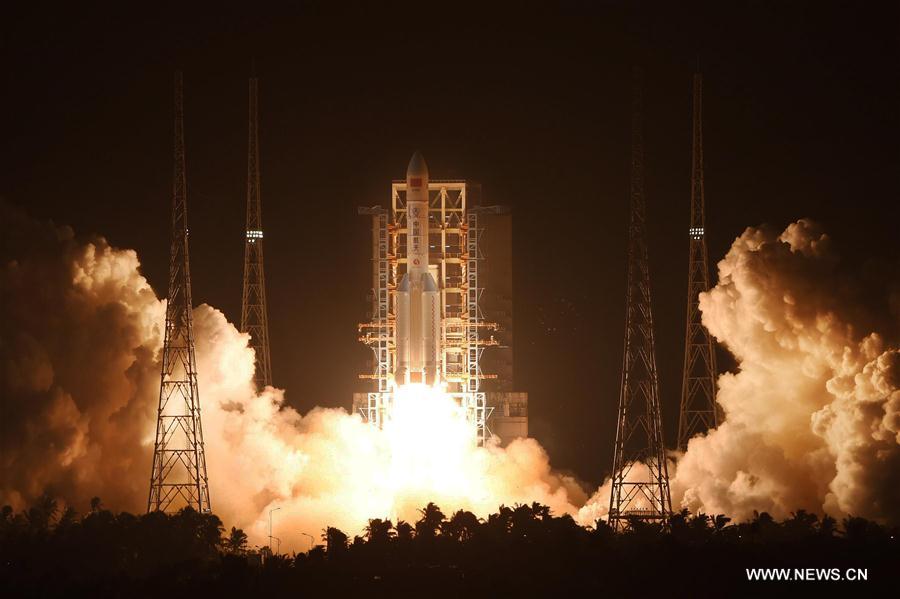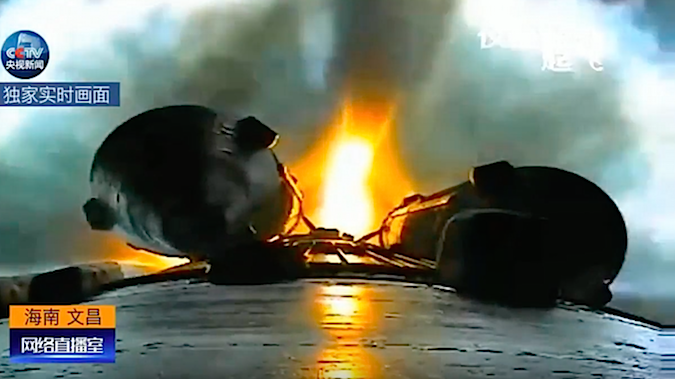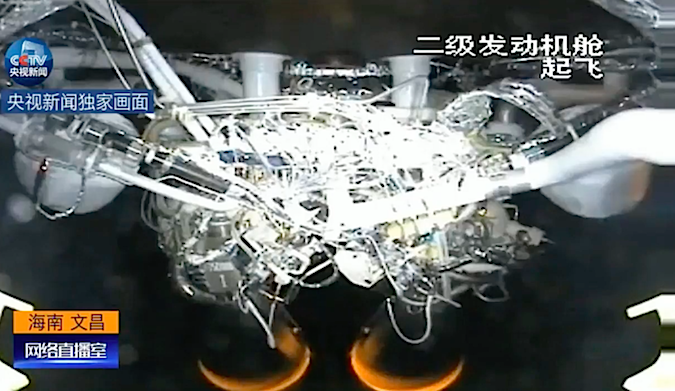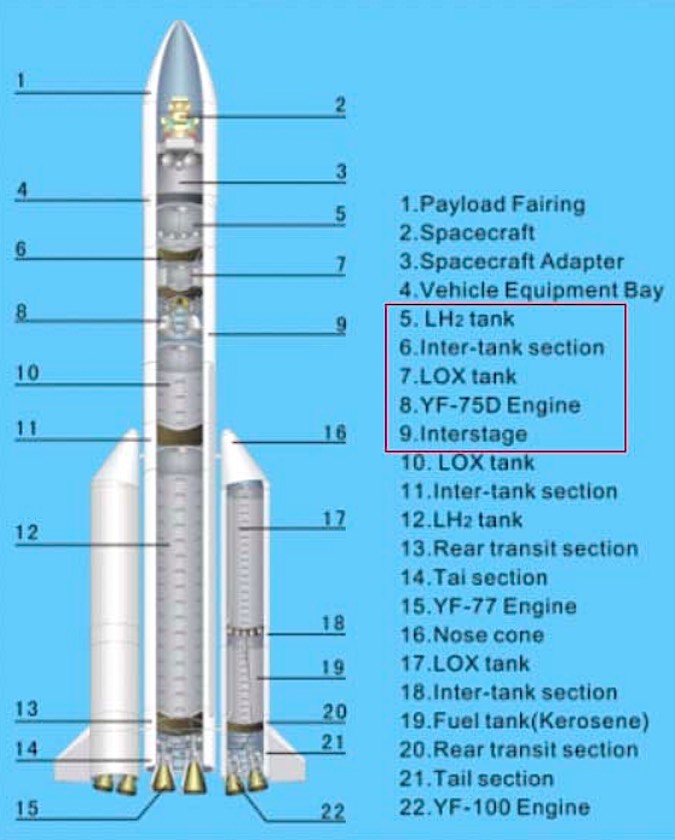| 美媒: 長5是世界上最強大火箭之一,超過俄質子和歐阿里亞娜5 |
| 送交者: 三把刀 2016年11月04日01:28:39 於 [軍事天地] 發送悄悄話 |
 China’s heavy-lift Long March 5 rocket fired into space on a successful inaugural flight Thursday, debuting a brand new launcher that can carry twice the payload of any other Chinese booster and setting a keystone for the country’s ambitions for a space station and interplanetary exploration. The maiden test flight gives China a rocket that nearly identically matches the capability of the world’s current space lift leader, United Launch Alliance’s Delta 4-Heavy rocket, and exceeds the performance of other heavy-lifters like Europe’s Ariane 5 and Russia’s Proton launcher. The Long March 5 rocket, the product of two decades of research and at least nine years of construction, fabrication and testing, is a centerpiece of China’s plans to assemble a permanently-crewed space station in orbit and send robotic missions to the moon and Mars. The powerful launcher, driven by 10 engines on its first stage and strap-on boosters, took off at 1243 GMT (8:43 a.m. EDT; 8:43 p.m. Beijing time) Thursday from the Wenchang space center on Hainan Island off the southern coast of the Chinese mainland. The launch was delayed nearly three hours to resolve concerns with a liquid oxygen venting system and temperatures inside the Long March 5’s engines. The rocket’s two core stage YF-77 engines, burning a mix of liquid hydrogen and liquid oxygen and flying on a rocket for the first time, ignited with a burst of orange flame in the final seconds of the countdown. Eight kerosene-fueled YF-100 engines, arranged in pairs of two on four strap-on rockets, fired seconds later to propel the beefy booster off the pad. The Long March 5 quickly soared through a deck of low clouds on top of 2.4 million pounds of thrust, and on-board cameras showed the rocket climbing into the stratosphere as it arced east from Wenchang over the South China Sea. A live video feed from Chinese state television shared on YouTube showed the Long March 5’s launch, and China’s official CCTV television channel began broadcasting the flight live on its English language service soon after the rocket’s successful liftoff. On-board cameras aboard the 187-foot-tall (57-meter) rocket showed the four liquid-fueled boosters falling away from the Long March 5’s 16-foot-diameter (5-meter) core stage around 2 minutes, 53 seconds, after liftoff.
An forward-facing camera captured the separation of the Long March 5’s 17-foot-diameter (5.2-meter) payload fairing at approximately T+plus 4 minutes, 45 seconds, once the rocket reached an altitude of more than 90 miles (147 kilometers). The fairing’s release revealed the mission’s experimental payload, Shijian 17, designed for an electric propulsion demonstration in orbit. The Long March 5’s first stage shut down and separated from the rocket’s upper stage at about T+plus 7 minutes, 55 seconds, as the launcher passed just north of the Philippines. Moments later, two hydrogen-fueled YF-75D engines mounted side-by-side on the upper stage flashed to live in an on-board camera view, prompting enthusiastic applause from launch controllers on the ground. The YF-75D engines are upgraded, restartable versions of China’s earlier single-use cryogenic upper stage engines. The twin-engine upper stage fired for around six minutes to reach a preliminary low-altitude parking orbit. The second stage coasted until it crossed the equator at around T+plus 27 minutes, then re-ignited the engines to climb into a higher altitude orbit, before deploying the Shijian 17 spacecraft and its Yuanzheng space tug about a half-hour after liftoff.
Chinese officials do not consider the Yuanzheng boost stage part of the Long March 5 rocket, and the launch team erupted into cheers as video streamed down to Earth showing the space tug receding into the blackness of space. The Yuanzheng’s main engine fired about a minute later to raise the high point of its orbit to an altitude of more than 22,000 miles (nearly 36,000 kilometers). A timeline of the mission displayed on screens in launch control indicated the stage would light its engine again around 1836 GMT (2:36 p.m. EDT), presumably to enter a circular geostationary orbit over the equator, then separate the Shijian 17 satellite at around 1857 GMT (2:57 p.m. EDT). China has disclosed little information about Shijian 17, except that it carries an electric thruster test package, a type of propulsion system that could give the spacecraft great maneuverability to efficiently adjust its orbit and move around the geostationary belt, home to most of the world’s communications satellites. Thursday’s successful launch will clear the way for China to send a robot to the moon next year on top of another Long March 5 rocket to retrieve and return samples from the lunar surface. The Chang’e 5 mission is the next step in China’s lunar program, which has so far dispatched two orbiters and a rover to the moon. A Long March 5 launch in 2018 is scheduled to loft the Tianhe 1 core section of China’s planned space station, and subsequent Long March 5 flights will add two more 20-ton research modules to the complex by 2022. Two Chinese astronauts are currently in orbit practicing procedures and testing technologies for the space station. The crew is living aboard the Tiangong 2 space lab, a precursor to the station outpost, for about a month. China’s first Mars rover set for launch to the red planet in 2020 will also need the Long March 5’s heavy-lift capability. The Long March 5 is the biggest of three new liquid-fueled Chinese rockets launched for the first time in the last 14 months. The Long March 6 light-class booster and the medium-lift Long March 7 rocket made their inaugural flights in September 2015 and in June, respectively.
The new rockets eliminate the use of toxic propellants like hydrazine and nitrogen tetroxide needed by China’s Long March 2, 3 and 4-series, replacing them with more environmentally-friendly kerosene and hydrogen. The Long March 5’s maiden flight debuted two new engine types — the YF-77 core engine and the YF-75D upper stage engine — that advance China’s rocket propulsion programs. The YF-77 is China’s first booster-class rocket engine to burn super-cold liquid hydrogen and liquid oxygen as propellants, and the largest such fully cryogenic powerplant ever made in China. The two YF-77 first stage engines are connected together with a structural thrust frame, and they each produce about 115,000 pounds of thrust at ground level, and up to 157,000 pounds of thrust in vacuum. The restartable expander cycle YF-75D is the latest upgrade to China’s long line of cryogenic hydrogen-fueled upper stage engines, which first flew on a space mission in 1984. The YF-100 engine flown on the Long March 5’s strap-on boosters is a more powerful model of Russia’s RD-120 rocket engine, and it consumes a mixture of rocket-grade kerosene and liquid oxygen. The YF-100 engine can produce up to 270,000 pounds of thrust at sea level. China acquired several RD-120 engines from Russia in the 1990s, and the YF-100 engine operates with oxygen-rich staged combustion, a closed propulsion cycle that minimizes propellant waste, resulting in a more efficient, but more complex, propulsion system. Most experts acknowledge Russia is the world leader in such propulsion technology. Two YF-100 engines are fixed to the base of each Long March 5 booster, but the engine type already launched on China’s Long March 6 and Long March 7 rockets on their inaugural flights. Thursday’s launch was the second spaceflight to blast off from the new Wenchang launch center, a seaside facility completed in 2014 to primarily serve as a base for the Chinese space program’s civilian missions. The tropical spaceport on Hainan Island is closer to the equator than China’s other launch facilities, giving rockets an extra boost in speed from Earth’s spin, and it allows launchers to drop their boosters in the ocean instead of on land. Chinese engineers have studied a heavy-lift booster since the 1990s, and China officially announced plans to develop the Long March 5 in early 2001. Full-scale development of the new YF-77 engine began in 2002. After winning government approval for the project, China broke ground on a new rocket factory for the Long March 5 and Long March 7 in the port city of Tianjin in 2007, when officials hoped to launch the Long March 5 for the first time in 2013. The maiden flight slipped to 2014, then 2015, before winding up in late 2016. One of the challenges faced by machinists and engineers was the fabrication of the Long March 5’s large tanks, requiring new tools and techniques to master the precision needed to weld and assemble the rocket’s 16-foot-diameter (5-meter) core, according to state media reports. The diameter of the Long March 5’s main stage is 50 percent wider than China’s other rockets. Engineers needed to widen the rocket tanks to accommodate a larger load of hydrogen fuel. China has at least two basic variants of the Long March 5 on the drawing board. The version selected for Thursday’s maiden test flight has a second stage for geostationary and interplanetary missions. China says it is capable of delivering a payload of up to 14 metric tons, or nearly 31,000 pounds, to geostationary transfer orbit, nearly identically matching the lift capability of ULA’s Delta 4-Heavy and exceeding that of the European Ariane 5 rocket. A shorter configuration without the second stage, named the Long March 5B, could place up to 25 metric tons, or 55,000 pounds, into low Earth orbit several hundred miles up, just shy of the Delta 4-Heavy’s capacity to the same orbit. |
|
|
|
|
 |
 |
| 實用資訊 | |
|
|
|
|
| 一周點擊熱帖 | 更多>> |
|
|
|
| 一周回復熱帖 |
|
|
|
|
| 歷史上的今天:回復熱帖 |
| 2015: | 我軍南沙新建基地到底是資產還是負擔? | |
| 2015: | C919,這一句話就引來不少仇恨! | |
| 2014: | 答季牧龍 面首 中文解釋 | |
| 2014: | 據說這張圖里有挪威海軍的照片 | |
| 2013: | 防務新聞:工程師們認為DDG1000存致命 | |
| 2013: | 殲31彈倉細節首曝 載彈不次美F35[組圖 | |
| 2012: | 零的突破!官方證實艦載機首次在航母“ | |
| 2012: | 海軍北海艦隊穿越宮古海峽遠洋訓練近照 | |
| 2011: | 司馬南提出的有反對的嗎? | |
| 2011: | 外媒稱神八對接水平世界最高:中國進入 | |






